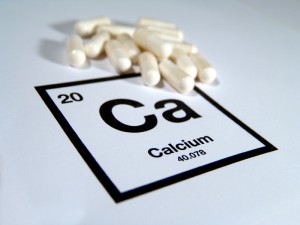With the increasing popularity of dairy free diets – Palaeolithic – and growing fear of coronary artery calcification, dietary calcium (Ca2+) intakes are decreasing. Low calcium intakes not only have implications for bone health, recent evidence has indicated Ca2+ may regulate body fat content, and increased Ca2+ intakes may actually enhance fat loss when combined with moderate energy restriction (Zemel et al. 2005). It is interesting to note that a number of studies are now illustrating the fact that high milk intakes seem to have certain abdominal anti-obesity effects regardless of the individual’s physical activity (Abreu et al. 2013). Reports have also indicated an inverse association between frequency of milk consumption and body mass in children (Barba et al. 2005). Such evidence clearly highlights the influence of dietary calcium Ca2+ intake on body fat content.
Mechanisms
Inadequate Ca2+ intake has been associated with increased body mass index and body fat content, suggesting dietary Ca2+ intake may have certain anti-obesity properties. Various studies have demonstrated a key role of intracellular Ca2+ in regulating adipocyte lipid metabolism. It appears dietary calcium modulates circulating calcitriol, which in turn is responsible for the regulation of adipocyte intracellular calcium. Using the agouti mouse model Zemel et al. (2000) reported the influence of intracellular Ca2+ on the accumulation of fat and obesity in these animals. This mechanism alludes that low dietary Ca2+ intakes result in an increase in 1,25-dihydroxy vitamin D which in turn stimulates Ca2+ influx into the adipocyte (fig.1). Increased dietary Ca2+ via parathyroid hormone (PTH) chronically lowers intracellular Ca2+ in the adipocyte. Thus either directly, or perhaps via insulin intracellular Ca2+ would regulate the expression of fatty acid synthase (FAS) – a key enzyme in the regulation of lipid deposition. In addition increased dietary calcium also stimulates adipose tissue lipolysis via its influence on cAMP production and thus the phosphorylation of hormone sensitive lipase (HSL). Intracellular Ca2+ results in a decrease in thermogenesis and reciprocal stimulation of lipogenesis, inhibition of lipolysis and thus causing an expansion of adipocyte triglyceride stores. Increased levels of 1,25-dihydroxy vitamin D levels is also responsible for the redistribution of body fat to the abdomen through the stimulation of cortisol. Increased dietary Ca2+ would also suppress 1,25-dihyroxy vitamin D levels, thus supposedly inhibiting adiposity and promoting weight loss (Zemel, 2009).
Existing evidence
A short-term Ca2+ supplement study on mice revealed Ca2+ intakes of 1.2% total energy lead to a 51% reduction in lipogenesis and a fivefold stimulation of lipolysis, resulting in a 29% decrease in body weight and a 36% decrease in fat mass (Zemel et al. 2000). She Ping-Delfos & Soares (2011) also reported an acute dose of high Ca2+ (543.2mg) at breakfast significantly increased whole body fat oxidation (p<0.02) and dietary induced thermogenesis (p<0.01) when compared to a low Ca2+ (248.2mg) breakfast. In a randomized, controlled, crossover study conducted in a whole room calorimeter Melanson et al. (2005) reported a high Ca2+ (~1,400mg/day-1 as dairy) diet suppressed calcitriol and resulted in a 30g/day-1 (270 kcal/day-1) increase in fat oxidation. Similarly a high Ca2+ (1000mg/day-1) diet increased diet induced thermogenesis over two successive meals, and more significantly the mean 1-year change in whole body fat oxidation was greater in the high Ca2+ group compared to low Ca2+ group (<800mg/day-1) (Gunther et al. 2005). However, more recent evidence using abdominal subcutaneous microdialysis indicates that Ca2+ (~1,400mg/day-1 as milk mineral) for 5-weeks did not stimulate lipolysis, glycerol turnover or fat oxidation (Bortolotti et al. 2008).
Some studies suggest that those with habitually low Ca2+ (<600mg/day-1) intakes benefit more from Ca2+ supplementation, as when Ca2+ deficiency exists the efficiency of Ca2+ absorption is improved (Soares et al. 2011). Further, Ca2+ supplements seem to augment fat oxidation to a greater degree than dairy Ca2+ (Gonzalez et al. 2012). This despite the fact that dairy Ca2+ appears to be more effective in weight and fat loss trials, possibly owing to the synergistic effects of the bioactive components within dairy.
Conclusion
Existing evidence suggests chronic (<7-days) high Ca2+ (~1,300mg/day-1) intake increases fat oxidation, which when combined with moderate energy restriction (-500kcal/day-1) may result in fat loss (Gonzalez et al. 2012).
Future research should aim to validate new evidence that fat oxidation is increased following acute Ca2+ intake, and distinguish the long-term effects of a high- Ca2+ diet on the rate of fat oxidation.
References
Abreu, S., Santos, R., Moreira, C., Santos, P., Vale, S., Soares-Miranda, L., et al… (2013). Relationship of milk intake and physical activity to abdominal obesity among adolescents. Pediatric Obesity, [ahead of print].
Barba, G., Troiano, E., Russo, P., Venezia, A., & Siani, A. (2005). Inverse association between body mass and frequency of milk consumption in children. British Journal of Nutrition, 93, 15 – 9.
Bortolotti, M., Rudelle, S., Schneiter, P., Vidal, H., Loizon, E., Tappy, L., & Acheson, K. (2008). Dairy calcium supplementation in overweight or obese persons: It’s effects on markers of fat metabolism. American Journal of Clinical Nutrition, 88, 877 – 885.
Gunther, C. W., Lyle, R. M., Legowski, P. A., James, J. M., McCabe, L. D., McCabe, G. P.,… & Teegarden, D. (2005). Fat oxidation and its relation to serum parathyroid hormone in young women enrolled in a 1-y dairy calcium intervention. American Journal of Clinical Nutrition, 82, 1228 – 1234.
Jawadwala, R. (2011) Dietary Calcium – A potential ergogenic aid? Book chapter in Duncan M. J. (Ed.) Trends in Human Performance Research. New York: Nova Science Publishers.
Melanson, E., Donahoo, W., Dong, F., Ida, T., & Zemel, M. (2005). Effect of low- and high-calcium dairy-based diets on macronutrient oxidation in humans. Obesity Research, 13, 2102-2112.
She Ping-Delfos, W., & Soares, M. (2011). Diet induced thermogenesis, fat oxidation and food intake following sequential meals: Influence of calcium and vitamin D. Clinical Nutrition, 30, 376 – 383.
Soares, M. J., Ping-Delfos, W. C. S., & Ghanbari, M. H. (2011). Calcium and vitamin D for obesity: a review of randomized controlled trials. European Journal of Clinical Nutrition, 65, 994-1004.
Zemel, M. B., Shi, H., Greer, B., Dirienzo, D., & Zemel, P. C. (2000). Regulation of adiposity by dietary calcium. The Journal of the Federation of American Societies for Experimental Biology, 14, 1132-1138.
Zemel, M.B., Richards, J., Milstead, A., & Campbell, P. (2005). Effects of calcium and dairy on body composition and weight loss in African-American adults. Obesity Research,13, 1218–1225.
Zemel., M. (2009). Proposed role of calcium and dairy food components in weight management and metabolic health. The Physician and Sportsmedicine, 37, 29 – 39.
Bio: Matt is the Lead Performance Nutritionist at PurePharma, and also runs his own business, Nutrition Condition UK. He holds a BSc (Honours) degree in Sport & Exercise Science, and an MSc in Nutrition Science. In 2010 Matt completed a 12-month Performance Nutrition internship with the Welsh Rugby Union, which allowed him an in depth insight into the  practical application of the nutrition knowledge he gained at university. He continues to work closely with the Welsh Rugby Union through the North Wales region RGC 1404. As Lead Performance Nutritionist at PurePharma he is responsible for the development and delivery of all the nutrition related information both on the website and in product marketing material, and also plays a major role in product innovation.
practical application of the nutrition knowledge he gained at university. He continues to work closely with the Welsh Rugby Union through the North Wales region RGC 1404. As Lead Performance Nutritionist at PurePharma he is responsible for the development and delivery of all the nutrition related information both on the website and in product marketing material, and also plays a major role in product innovation.
Through his own Performance Nutrition business, Nutrition Condition he delivers frequent Health & Wellbeing Workshops to corporate and personal clients advising on how best to develop a sound, scientifically structured nutrition programme free from fads and marketing bias. Nutrition Condition also delivers Performance Nutrition services to professional athletes.
Matt can be contacted on matt@purepharma.com or matt@nutritioncondition.com
For regular updates follow Matt on Twitter @mattncuk.

 Heavy lifting is really more when one is lift for either a one max rep (the heaviest weight they can do for one repetition) or only a few repetitions. This is not typically your weight loss, body shaping weight training protocol. For general conditioning and weight reduction, you still have to have enough weight to make it challenging, but it still isn’t considered “heavy”.
Heavy lifting is really more when one is lift for either a one max rep (the heaviest weight they can do for one repetition) or only a few repetitions. This is not typically your weight loss, body shaping weight training protocol. For general conditioning and weight reduction, you still have to have enough weight to make it challenging, but it still isn’t considered “heavy”.
